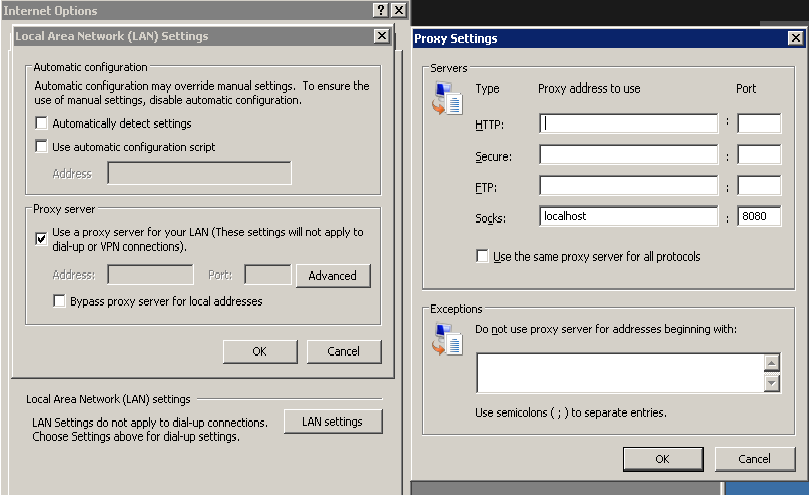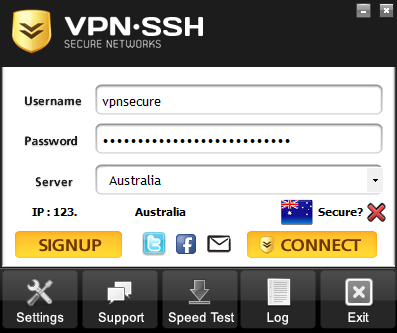

- #Ssh proxy server windowns manual
- #Ssh proxy server windowns full
- #Ssh proxy server windowns plus
- #Ssh proxy server windowns series
- #Ssh proxy server windowns download
Note: For reasons of simplicity we used the SSL certificates which were created directly by the IIS. In the PRTG web interface, configure the same DNS name ( Setup | System Administration | User Interface, option DNS name in previous PRTG versions: Setup | System & Website) as you will use for the IIS later.On the machine running the PRTG core server, open the PRTG Server Administrator tool and configure the PRTG web server to run without SSL on http (a custom http port may be used).For further reference see end of the article. Note: The mentioned modules are not part of the IIS by standard. Make sure the machine running PRTG is accessible from the machine running IIS.Activated modules: URL Rewrite 2, AAR 2.5, WFF 2.0.Basic knowledge of the IIS web server and the URL Rewrite module.There are some prerequisites that must be met if you plan to follow this article: You might need to apply some security adjustments!!! Using Windows IIS Web Server as SSL Proxy for PRTG
#Ssh proxy server windowns full
This article does NOT describe a full configuration of the IIS.
#Ssh proxy server windowns manual
Check out ssh's manual page ( man ssh) sometime to discover all of the different options available with this seemingly simple program.This article applies to PRTG Network Monitor 12 or later and IIS 7 and above While it might mostly be used in its simplest form, ssh there are literally dozens of uses, with flags and configurations to make connections from one host to another. With this setting in ~/.ssh/config, any ssh connection to the remote host is accomplished by forwarding stdin and stdout through a secure connection from bastion-host. Prox圜ommand in ~/.ssh/configĪs with ProxyJump, Prox圜ommand can be set in the ~/.ssh/config file for hosts that always use this configuration: Host remote-host

The %h:%p arguments to the -W flag above specify to forward standard in and out to the remote host ( %h) and the remote host’s port ( %p). The Prox圜ommand itself is a specific command used to connect to a remote server-in the case of the earlier example, that would be the manual ssh command used to first connect to the bastion: $ ssh -o Prox圜ommand="ssh -W %h:%p bastion-host" remote-host

Prox圜ommand works by forwarding standard in (stdin) and standard out (stdout) from the remote machine through the proxy or bastion hosts. ProxyJump is the simplified way to use a feature that ssh has had for a long time: Prox圜ommand. An alternative: Forwarding stdin and stdout The ssh command first creates a connection to the bastion host bastion-hostname (the host referenced, by nickname, in the remote host’s ProxyJump settings) before connecting to the remote host. Using the example configuration above, when an ssh connection is made like so: $ ssh remote-host-nickname The -J flag provides flexibiltiy for easily specifying proxy and remote hosts as needed, but if a specific bastion host is regularly used to connect to a specific remote host, the ProxyJump configuration can be set in ~/.ssh/config to automatically make the connection to the bastion en-route to the remote host: # The Bastion Host For example, a public bastion host giving access to a "web tier" set of hosts, within which is a further protected "database tier" group might be accessed. This feature is useful if there are multiple levels of separation between a bastion and the final remote host.
#Ssh proxy server windowns series
The ssh man (or manual) page ( man ssh) notes that multiple, comma-separated hostnames can be specified to jump through a series of hosts: $ ssh -J, You can also set specific usernames and ports if they differ between the hosts: $ ssh -J
#Ssh proxy server windowns plus
To use it, specify the bastion host to connect through after the -J flag, plus the remote host: $ ssh -J The ProxyJump, or the -J flag, was introduced in ssh version 7.3. Instead of first SSHing to the bastion host and then using ssh on the bastion to connect to the remote host, ssh can create the initial and second connections itself by using ProxyJump. The ssh command has an easy way to make use of bastion hosts to connect to a remote host with a single command.

#Ssh proxy server windowns download


 0 kommentar(er)
0 kommentar(er)
